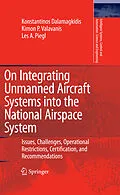This is the only book that presents in a comprehensive way current manned aviation regulation, airworthiness certification, special aircraft categories, pilot certification, federal aviation requirements, operation rules, airspace classes and regulation development models.
It is the first book that discusses unmanned aircraft systems levels of safety derived mathematically based on the corresponding levels for manned aviation. It provides an overview of the history and current status of UAS airworthiness and operational regulation worldwide. Existing regulations have been developed considering the need for a complete regulatory framework for UAS. It focuses on UAS safety assessment and functional requirements, achieved in terms of defining an "Equivalent Level of Safety", or ELOS, with that of manned aviation, specifying what the ELOS requirement entails for UAS regulations. To accomplish this, the safety performance of manned aviation is first evaluated, followed by a novel model to derive reliability requirements for achieving target levels of safety (TLS) for ground impact and mid-air collision accidents.
It discusses elements of a viable roadmap leading to UAS integration in to the NAS.
Klappentext
This is the only book that presents in a comprehensive way current manned aviation regulation, airworthiness certification, special aircraft categories, pilot certification, federal aviation requirements, operation rules, airspace classes and regulation development models.
It is the first book that discusses unmanned aircraft systems levels of safety derived mathematically based on the corresponding levels for manned aviation. It provides an overview of the history and current status of UAS airworthiness and operational regulation worldwide. Existing regulations have been developed considering the need for a complete regulatory framework for UAS. It focuses on UAS safety assessment and functional requirements, achieved in terms of defining an Equivalent Level of Safety, or ELOS, with that of manned aviation, specifying what the ELOS requirement entails for UAS regulations. To accomplish this, the safety performance of manned aviation is first evaluated, followed by a novel model to derive reliability requirements for achieving target levels of safety (TLS) for ground impact and mid-air collision accidents.
It discusses elements of a viable roadmap leading to UAS integration in to the NAS.
Zusammenfassung
Commercial interest for unmanned aircraft systems (UAS) has seen a steady increase over the last decade. Nevertheless, UAS operations have remained almost exclusively military. This is mainly due to the lack of a regulatory framework that allows only limited public and civil UAS operations with usually crippling restrictions. Although efforts from the Federal Aviation Administration and its partners are already underway to integrate UAS in the National Airspace System (NAS), the appropriate regulation will not be ready for several more years. In the meantime UAS developers need to be aware of the current operational restrictions, as well as make informed decisions on their research and development efforts so that their designs will be airworthy when the regulatory framework is in place.
This monograph aims to present an overview of current aviation regulation followed by an investigation of issues and factors that will affect future regulation.
Inhalt
Aviation History and UAS.- Current Manned Aviation Regulation.- Unmanned Aircraft Systems Regulation.- UAS Safety Assessment and Functional Requirements.- Thoughts and Recommendations on a UAS Integration Roadmap.- Epilogue.
